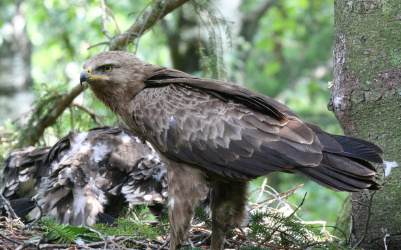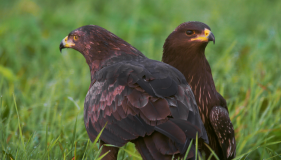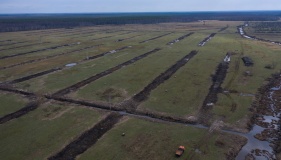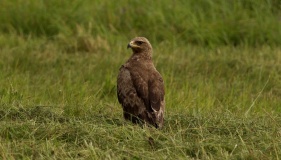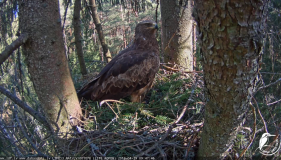One of the project goals is to find new Lesser spotted eagle nests in Latvia. What does it mean - to find a new nest? How do experts search for nests? Finding a nest is a task that requires time and patience, as well as well trained expert skills - ability to distinguish the silhouette of Lesser spotted eagle from other other eagles and to recognize it's voice.
The process of searching for nests usually goes like this. Expert visits a territory and at the beginning tries to catch sight of lesser spotted eagle or pair of them. That means – patient observation and investigation of the surroundings. If the expert succeeds and a bird appears, it is worth to pay attention whether there could be nest nearby. Lesser spotted eagles mostly stay in their own territory where they nest and forage. Therefore, if the expert sees an eagle and the location is surrounded by suitable feeding grounds and there is a good forest nearby, there is a high possibility that in this location a nest will be found.
The next step is to narrow the search area in order to understand in which group of trees there could be the nest. The best time for this is autumn, winter and early spring when trees are without leaves.
Nest searching requires also preparation work at home – research of forest territories in data bases can give information about the locations that are suitable for lesser spotted eagles. For example, we know that Lesser spotted eagle needs forest that is older then 70 years. When the expert selects certains partitions according to these criteria, it is easier to do fieldwork in nature. What could look like a simple walk in the forest, for the expert is a thorough work – listening for lesser spotted eagle sounds and following that direction, observing the forest and birds. For example, if you see a lesser spotted eagle carrying a frog in its beak and it is July, it is clear that the bird is bringing food to the nest.
When the expert sees the nest, it is important to clarify if it is a nest of lesser spotted eagle. Lesser spotted eagle sometimes exchanges the nest with other birds of pray or uses the nest of black stork. When being close to the nest, it is important to be quiet, not to disturb the bird. Then the expert writes down the coordinates, takes photos of the nest, describes its location, condition and all other information.
The search for one nest can take one to three days. It also happens that the expert find the nest, but are not confident that it is nest of lesser spotted eagle. In these cases the nest is revisited in next season.
Currently the expert have found almost 100 new lesser spotted eagle nests and field work of this season is still going on.


